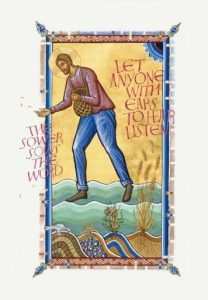
This illumination illustrates Ezekiel 37: 1-14, in which God sets Ezekiel in the middle of a valley filled with dry bones, representing a destroyed society cut off from faith. Ezekiel preaches the word of God to the bones, and God promises the bones that He will “put my Spirit in you and you will live, and I will settle you in your own land.” You will find many human bones in this illumination, as well as the figurative bones of civilization.
In The Art of the Saint John’s Bible, Susan Sink relates how Donald Jackson began work on this illumination with an Internet search, looking for documentary photos of human suffering.
“The skulls are based on photos taken of genocide and war in Armenia, Rwanda, Iraq, and Bosnia. The piles of broken glass suggest the broken windows caused by car bombs…. At the center is a pile of eyeglasses, a well-known image from the Holocaust. […] For Donald Jackson the waste of ecological disaster is part of the larger image…. The three automobile hulls are one sign of the spiritual death of society.” (Sink, vol. 2, p. 82)
Yet throughout the image we find glimmers of hope. Note the splash of oil on the right-hand page, with a rainbow sheen connecting the dry bones to the exultant rainbow at the top. Remember the gold squares from the Creation image? They are present here, indicating divine watchfulness.
Finally, note the seven menorahs, a sign throughout the Saint John’s Bible of creation and covenant. Sink notes: “Here the seven gold and black bars are intersected by arcs that end in points of light. Seven menorahs with seven points of light rise out of and transcend the wreckage and wrongdoings of humankind….” (Sink, vol. 2, p. 83)

 Like the
Like the